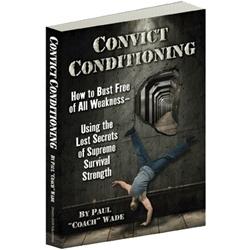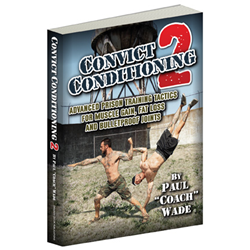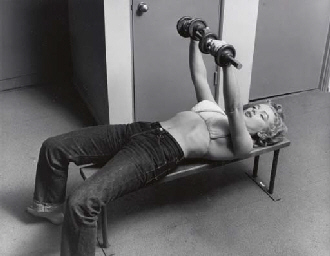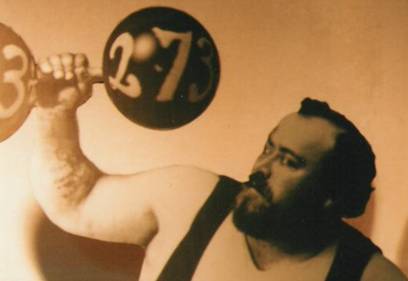It doesn't matter where you strike up the conversation. It could be in the internet or in real life. Either way, whenever the subject of weights vs bodyweight comes up, someone eventually takes the middle ground and says something to the effect of, "why not do weighted calisthenics? There's no need to argue when you can combine the best of both worlds. There's no rule book that says it's not BW if there's added weight."
Okay, let's compromise! There's been enough bickering about the whole weights vs. BW. Let's all be friends and talk about weighted Calisthenics. Generally, two exercises get the call when it comes to adding weight: Dips and pull-ups. There are others you can do, of course, but these two are the most accepting of using a wider array of weighted material to do the exercise since you hang to execute them, thus creating lots of open space around you.
So, we've got our base exercises to weigh down. The question now is: with what? There are a lot of different things that you can use to add weight to calisthenics. the most common are:
- Weighted Vests
- Dip Belts
- Chains
- Backpacks
- Dumbbells
Over the past year and a half, I've had the opportunity...wait, not the right choice of words...I've been forced to improvise and use all but the weighted vest. They're not all the same and each one has its benefits and drawbacks, so I'll go over them one at a time, based on my experiences.
 Backpacks
BackpacksThis is, without a doubt, the cheapest way to get into weighted calisthenics, if you already have a pretty durable backpack. You can throw weight plates or bags of sand (whichever you have handy) into the bag and get going. Backpacks are an easier weight to pull or dip with. I'm tempted to talk about leverage in relation to weight distributions but since I always seem to stick at least half of my foot in my mouth with such talk, I'll just say this: Something about the weight placed on the back feels easier to me. So, if you're looking to progress with more weight, you're probably going to hit a wall. For most backpacks, it's going to be difficult to get much more than 75 lbs in the bag and still have the bag hold up to the load. Of course, that just means that you need to find another way to make the exercise harder. I did a lot of my famous towel pull-ups with my 40 lbs tool backpack. I didn't miss not having an extra 15-20 lbs back there!
Dip BeltsProbably the most common tool to do weighed dips and pull-ups and for good reason. If putting lots and lots of weight on your dips,pulls and chins is your game, then you need a dip belt. You just can't get as much weight onto your pulls and dips with any other tool as you can with a dip belt. Reasonably inexpensive (if you already have the weights), cheap and easy to make one of your own and capable of using several different pieces of weight (plates and kettlebells being the most common), this would make the most sense for weighted calisthenics. I also notice that the weight dangling between the legs makes the exercise harder than loading it on the back. So, you get more work out of the weight this way. Plus, this method is also reasonably comfortable, even with a lot of weight.
 Chains
ChainsFor sheer versatility, chains completely blow everything else out of the water. You can use them so many different ways (make necklaces, bandoleers, or make a dip belt out of it, if you have the right fasteners) in addition to using them on barbells for squat, deadlift and overhead work. If you make a chain bandoleer, push-ups become an option for weighted calisthenic work too! I don't know how much self-image plays into your training but if you want to look like the most hardcore, Metallica-blaring, raw-meat eating muthafucka' in your gym, then chained calisthenics are the way to go! It just looks flat-out cool to work with them!

As cool as they look, chains were made to tie machinery down and lift machinery up. They weren't made to be worn and there's the rub (literally) with chains: they're not comfortable to work with. You might want to add towels for padding and keep your shirt on. It's not like anyone wanted to see your chest that badly anyway (unless you happen to be a young woman). Strike two with chains is that they are expensive. If you're one of those people who figures out the cost per lbs of your weights, then chains will give your cheap bastard heart an attack. While it's cheaper to buy smaller diameter chain, it's also easier to tangle up.
NOT FUN! The big stuff can be purchased at rigging or trailer supply stores but like I said, it's expensive! I personally like the 1/2" chain the most. It's a good blend of weight, price, and ease of use. If you go this route, go for what's called Grade 30 or Grade 40 (sometimes called grade 3 or 4 as well). It's a lot cheaper than the higher grades (Grade 80, used for lifting tens of thousands of pounds overhead. You obviously don't need to pay extra for this kind of durability if all you're using it for is weight).
DumbbellsI've used dumbbells (and dumbbell-like objects) with dips, pulls and chins quite a bit. All you've got to do is pinch the handle in between your legs, either just below the knees or the ankles. Then, pull or dip.

I made it sound easy, didn't I? While this is very simple, and accessible if you have dumbbells already, it's also very hard to do. In fact, putting a dumbbell between the legs while pulling or dipping is probably the hardest position I've found when adding weight. So, it doesn't take a lot of weight to add some serious challenge to the movement. It'll also throw some leg work into these primarily upper body movements. Talk about confusing muscles!
Is the downside that you need a partner to put the dumbbell in between your legs? Not necessarily so. A few nights ago, I was playing around with dips with a flanged piece of 8" ductile iron pipe. Standing this chunk of iron on the ground, I'd lower myself down, grab the pipe in between my legs, and proceed on with the dips. When I finished, I'd lower myself back down and put the pipe back on the ground. I imagine that alternating between weighted and unweighted dips could be fun too!
What about the weighted vest? Eh. I've got a dip belt, my tool backpack, chains and a couple of dumbbells so I don't see the point. Besides, I've never really been impressed by them. Most weighted vests with any decent amount of weight cost a small fortune, even when compared to big-ass chain. In my not-humble and non-expert opinion, if one had a dip belt and some chain, there's no good reason to invest in the vest. The only advantage I see in them is that, unlike most of the others, they're actually made to be used with calisthenics. So, it's more comfortable but when do most of us care about comfort when we're training?
I recall a while back reading that sometime after he made his hundreds of millions of dollars convincing people that they needed a barrage of machines to make a strong body, Arthur Jones admitted that most people could take themselves to their absolute peak of upper body strength with just weighted dips and weighted pull-ups. Considering the source of the weight machine craze said this, it certainly carries some real weight. Had I just pulled a fast-one on the strength training public and made a fortune that my great-grandchildren couldn't possibly blow while doing it, I'd be very tempted to tell the truth too. You know, just to rub it in everyone's face!
Or, it shows that there really is room for compromise in our often-times uncompromising sub-culture.
 OOPS! Sorry, kids...
OOPS! Sorry, kids... Good example of less-than ideal settings to train.
Good example of less-than ideal settings to train. 





























